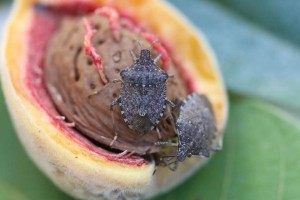NOTE – CDFA offers the Report a Pest app for those taking pictures of bugs in their gardens, or collecting specimens, and desiring help in identifying them.
By Debbie Arrington
As any gardener can tell you, bugs are always on the move.
How do we know when they’ll show up in our yard? We usually don’t – until after they’ve already made themselves at home, feasting on their favorite plants. We try to deal with these unwelcome guests only after we see the damage they caused.
What if there was some sort of advance warning system for garden pests? We could cover our crops and save our tomatoes. We could prepare for infestations before they hatch. We could beat the bad bugs.
With the introduction in California of Asian insects such as brown marmorated stink bugs and Japanese beetles, pest tracking is a global issue. Bad bugs can invade from anywhere.
That’s part of the appeal of the Big Bug Hunt, an international online effort to track insects via citizen science.
“The aim of the Big Bug Hunt is to make it easy for gardeners to report any pests or beneficial insects they see in their gardens,” explained bug hunter Ben Vanheems, who is based in the English village of Chipping Norton. “We’re then using that data to build up a picture of how pests spread. By combining it with meteorological data and the expertise of the university researchers, we’re creating the first intelligent pest prediction service for gardeners.”
With the help of University of York in England, the Big Bug Hunt was launched by the creators of GrowVeg.com, a top provider of gardening apps. It’s a free service that can be accessed online at www.bigbughunt.com.
Still in its larval stage, the Big Bug Hunt has big goals, but so far needs more real-time data to accurately map pest infestations.
“The app collects reports from gardeners around the U.S. and the world and combine these with the latest developments in computer statistical analysis,” Vanheems said.
Pest control ranks among the top concerns of gardeners anywhere, he said. When fighting voracious pests, organic methods often need a head start to be effective.
“We’re tracking everything, from essential beneficial insects such as bees whose population has been so dramatically reduced recently, right through to aphids and slugs, and we’ll be making the results available as the data is analyzed,” said Jeremy Dore, founder of GrowVeg parent Growing Interactive.
“Many organic control methods need to be put in place before pests strike – and it’s often too late to save a crop once the bad bugs have arrived,” Vanheems said.
Subscribers get a weekly email with updates. In return, bug hunters are asked to report insects – both good and bad – that they spot in their own gardens.
“Obviously some pests will be more regularly reported than others, and it is these pests that we are likely to be able to predict the spread of first of all,” Vanheems said. “We hope that pests such as aphids, carrot rust fly and whitefly will be the ones that we can develop prediction services for first. However, the conditions that cause pests to emerge are interrelated, which is why all reports are helpful.”
The pest reporting website is quick and easy, he added. “It takes less than 15 seconds to report a pest. There are also extensive pest identification guides available and our weekly newsletter includes tips on what to look out for and downloadable resources, tips and videos.”
The more reports, the more bug information, such as interactive maps of pests spreading across the country, will be available for others.
“In time, we will develop a full pest prediction service that will alert gardeners when pests are heading their way – either by email or within dedicated apps – so they can take evasive action,” Vanheems said.



